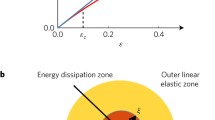Abstract
The experimentally known phenomenon that originally collinear mode I cracks seem to avoid each other before coalescence is studied by investigating the stability of straight crack paths. To this end a periodic array of approximately collinear but slightly curved cracks is considered. Stress intensity factors for modes I and II are derived and the growth of originally straight cracks under mode I conditions is studied after introduction of a disturbance that forces the cracks to deviate from a straight path. It is shown that the straight crack path is unstable, i.e. that tip to tip coalescence will not take place.
Résumé
En analysant la stabilité des chemins rectilignes de fissuration, on étudie le phénomène constaté expérimentalement suivant lequel des fissures colinéaires originellement de mode I semblent s'éviter l'une l'autre avant coalescence. A cette fin, on considère une série périodique de fissures approximativement colinéaires encore que légèrement courbées. Les facteurs d'intensité de contrainte pour les mode I et mode II sont déduits, et on étudie la croissance des fissures originellement droites de mode I après introduction d'une perturbation qui oblige ces fissures à dévier de leur trajet rectiligne. On montre que le chemin de fissuration rectiligne est instable, c'est-à-dire qu'une coalescence d'une extrémité vers une autre extrémité ne peut prendre place.
Similar content being viewed by others
References
R.V. Gol'dstein and R.L. Salganik, Izvestiya An SSSR, MTT, 3 (1970) 69–82 (in Russian).
R.V. Gol'dstein and R.L. Salganik, International Journal of Fracture 10 (1974) 507–523.
R.V. Gol'dstein and L.N. Savova, Izvestiya An SSSR, MTT, 2 (1972) 69–78 (in Russian).
B. Cotterell and J.R. Rice, International Journal of Fracture 16 (1980) 155–169.
F.A. McClintock and A.S. Argon, Mechanical Behavior of Materials, Addison-Wesley (1966).
N.I. Muskhelishvili, Singular Integral Equations, P. Noordhoff Ltd., Groningen, Holland (1953).
S.T. Melin, “Why do cracks avoid each other?” Report 1:82. Division of Solid Mechanics, Lund Institute of Technology, Lund, Sweden (1982).
F. Erdogan and G.C. Sih, Transactions of the ASME, ser. D, 85, 4 (1963) 519–525.
B.L. Karihaloo, L.M. Keer, S. Nemat-Nasser and A. Oranratnachai, Journal of Applied Mechanics 48 (1981) 515–519.
Author information
Authors and Affiliations
Rights and permissions
About this article
Cite this article
Melin, S. Why do cracks avoid each other?. Int J Fract 23, 37–45 (1983). https://doi.org/10.1007/BF00020156
Received:
Revised:
Issue Date:
DOI: https://doi.org/10.1007/BF00020156




